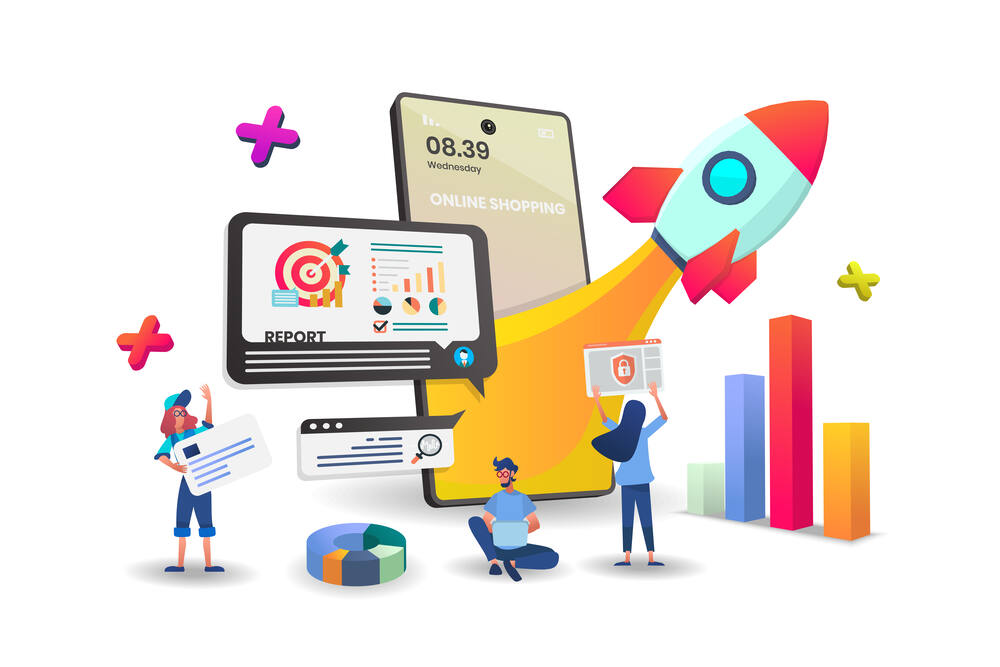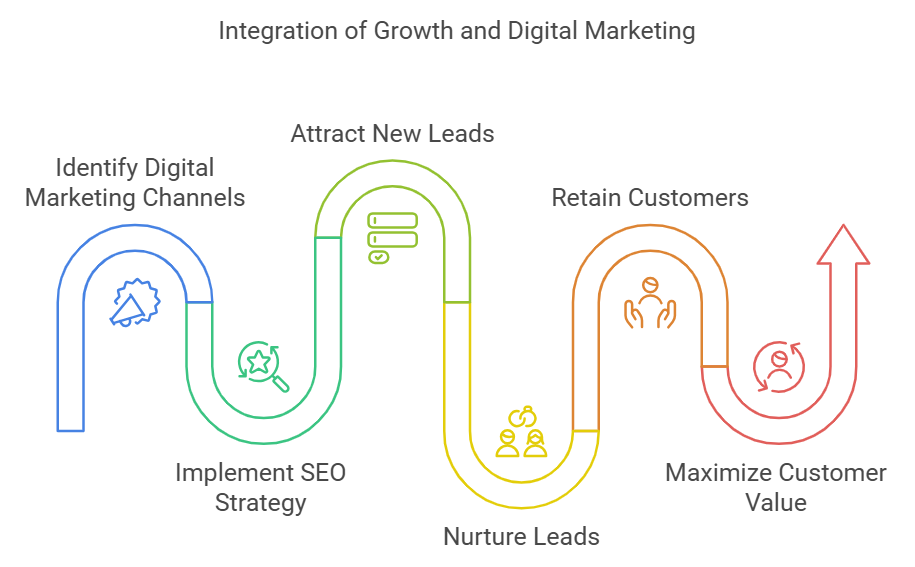What Is A Sales Development Representative (SDR)? Role, Skills, Qualifications, Challenges
More and more companies are hiring SDRs to help with their sales process and increase revenue.

Discover the key differences between growth marketing and digital marketing, their goals, and how they impact business strategies.
In today’s fast-paced marketing landscape, companies are constantly searching for the best ways to connect with their audience, drive revenue, and grow sustainably. Among the many strategies available, two that often stand out are growth marketing and digital marketing.
While both aim to maximize a business’s success, they are distinct in their focus, approach, and implementation. In this article, we’ll break down the core differences between these two approaches, helping you understand which strategy may best suit your business.
Growth marketing is an advanced, data-driven approach that prioritizes not just acquiring new customers but retaining them, driving customer engagement, and encouraging long-term loyalty. The foundation of growth marketing is built on experimentation, continuous optimization, and a holistic view of the entire customer journey.
At its core, growth marketing doesn’t stop at acquisition. Instead, it integrates the entire customer lifecycle, including activation, retention, referral, and revenue. It leverages various techniques, including A/B testing, cohort analysis, and customer feedback loops, to continuously refine marketing efforts and maximize growth potential.
By focusing on the broader picture, growth marketers aim to turn one-time customers into repeat buyers, boosting not just short-term wins but long-term, sustainable growth. You can see how this approach impacts businesses that focus on growth marketing.
Digital marketing, on the other hand, encompasses a wide array of online marketing efforts aimed primarily at acquiring new customers. It involves using digital channels—such as social media, search engines, email marketing, and content marketing—to promote products or services.
Unlike growth marketing, which focuses on retention and customer lifecycle, digital marketing is primarily focused on acquisition. Its goal is to get a company’s message in front of as many potential customers as possible and convert them into paying customers.
Digital marketing tactics range from SEO and paid advertising to social media campaigns and email promotions. It is often channel-driven, with each digital platform playing a role in building brand awareness, generating leads, and increasing conversions.
Traditional businesses transitioning to online strategies rely heavily on digital marketing to reach a larger audience, as explained in this digital marketing explanation.
One of the most significant distinctions between growth marketing and digital marketing lies in their approach. Growth marketing is hyper-focused on data and continuous experimentation. Marketers in this field constantly test new ideas, iterate on results, and use detailed analytics to fine-tune their strategies.
It’s about using real-time data to figure out what works best, which audiences respond better, and how to optimize each step in the customer journey.
Digital marketing, on the other hand, often revolves around mastering individual channels—such as running successful Facebook ads, optimizing content for search engines, or managing email campaigns. While digital marketers also rely on data, their focus is more on optimizing specific channels rather than the entire customer lifecycle.
Growth marketing doesn’t stop once a lead is converted into a customer. Instead, it takes a holistic view of the customer journey, focusing on improving the entire lifecycle—from initial acquisition to retention, referrals, and beyond.
By optimizing each touchpoint, growth marketing ensures that customers are more likely to stay with the brand and continue generating value over time.
Digital marketing, however, tends to focus more heavily on acquisition. It’s designed to bring new customers into the fold, often without as much focus on what happens after the first purchase. This acquisition-first mindset can lead to high churn rates if not complemented with strategies that promote customer retention. You can explore more about this comparison in Howuku’s take on the difference.
Experimentation is at the heart of growth marketing. Successful growth marketers constantly test hypotheses and measure their effectiveness through controlled experiments like A/B testing. These tests can involve everything from tweaking landing page designs to experimenting with email subject lines or testing different call-to-action buttons.
This method of continuous testing sets growth marketing apart from more traditional forms of digital marketing, where strategies are often set in advance and followed through without much room for iteration. In growth marketing, if a strategy doesn’t yield the desired results, it is adjusted or discarded in favor of one that performs better.
When it comes to goals, the differences between growth and digital marketing become even more apparent. Growth marketing is driven by the goal of long-term, sustainable customer growth and revenue generation.
It isn’t just about getting more leads—it’s about turning those leads into loyal customers who come back time and again, helping the business grow through repeat purchases and referrals.
On the other hand, digital marketing often focuses on short-term goals like increasing brand engagement, generating leads, and boosting online visibility. While these are important objectives, digital marketing’s emphasis on engagement can sometimes overshadow the need for retention and customer loyalty strategies.
Growth marketing utilizes a multichannel approach to reach and nurture customers. While digital marketing often focuses on individual platforms—like SEO, social media, or email marketing—growth marketing integrates efforts across multiple channels.
A growth marketing campaign might use a mix of email, social media, paid ads, and even organic content to push a customer through the funnel.
This multichannel strategy ensures that customers remain engaged across different touchpoints, enhancing their overall experience and increasing the likelihood of long-term retention. The broader and more integrated the approach, the greater the chances for sustainable growth.
One of the main reasons businesses are increasingly adopting growth marketing is its ability to offer a higher return on investment (ROI).
Growth marketing’s strategic, data-driven approach allows businesses to invest their marketing dollars more wisely, optimizing campaigns for maximum impact and minimal waste. Growth marketing often generates more sustainable revenue by focusing on long-term customer relationships.
In comparison, digital marketing can sometimes struggle with fluctuating ROI, particularly when efforts are concentrated on paid channels or when audience targeting isn’t precise.
The lack of continuous optimization and customer retention strategies can lead to diminishing returns over time. You can explore more about ROI comparison in Evenbound’s blog.
While growth and digital marketing have their differences, they aren’t mutually exclusive. Many businesses find that integrating both strategies can produce the best results.
Digital marketing channels—like SEO, social media, and content marketing—can serve as the foundation for growth marketing initiatives. For instance, a well-optimized SEO strategy can bring in new leads, which growth marketing can then nurture and retain.

When combined, these approaches create a well-rounded strategy that covers both acquisition and retention, ensuring a steady stream of new customers while also maximizing the value of existing ones.
So, which strategy should your business focus on—growth marketing or digital marketing? The answer largely depends on the size, stage, and goals of your company.
If you’re unsure which path is right for you, consider speaking with a growth marketing consultant. They can help you determine the best approach based on your current business needs. Learn more about how growth consulting can help.
Growth marketing and digital marketing serve different purposes, but they both play a crucial role in helping businesses succeed in the modern digital age. Growth marketing focuses on the full customer journey, prioritizing retention and long-term growth, while digital marketing is more focused on acquiring new customers and building brand awareness.
By understanding the key differences between these strategies, you can make more informed decisions about how to allocate your marketing resources, ensuring that your business not only grows but thrives.